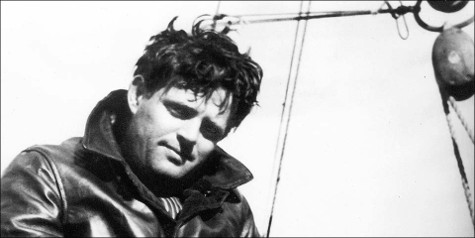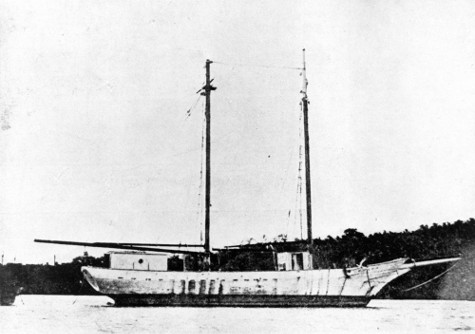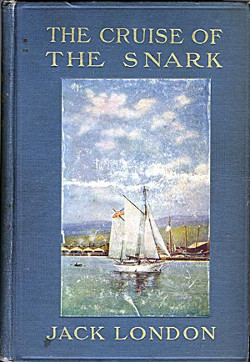
The idea for high adventure came to Jack London (1876-1916) and his wife, Charmian, almost as a lark while swimming in their pool in Glen Ellen, California—but it wasn’t a hard sell. He had been batting the idea around in his head for the better part of a decade, and, as an adrenaline junkie by today’s standards, coupled with his love for the sea, the notion proved too irresistible for London. So, the pair found they had talked themselves into a quest, a journey by a ketch around the world, and serious preparations began almost immediately.
Christened as The Snark (after Lewis Carroll’s poem “The Hunting of the Snark”), the 45-foot-long boat was custom built to be state-of-the-art, enabling London to work on his various writing projects while at sea. It would be powered by wind on the open waters, while a motor would propel them through exotic ports of call. They enlisted a full-time cook to prepare their meals from a well-stocked pantry. Then, to complete the crew—as well as to seek a bit of publicity in the process—London put out the word that he was taking applications for the voyage.
He was swamped with responses from all over the world, some people willing to pay him to go along! He selected a twenty-two year old named Martin Elmer Johnson, who reminded London of himself at that age; Charmian’s uncle Roscoe Eames, who lied about his seagoing expertise (London would later exclaim, “He is no more a sailor than I am an Egyptian dancing girl”); a cabin boy named Paul Tochigi; and Bert Stolz as mate and engineer.

The intended seven-year cruise was scheduled to embark on October 1, 1906, but as construction issues surfaced, the date got pushed back to April 23, 1907. The delays prompted London to move closer to the dock, where he could oversee the details and speed the process along—though there is no evidence that it made a spit of difference, and he grew befuddled to explain the postponements when anyone inquired. Following a last-minute attempt by a creditor to gouge him for more money, they were finally set to sail. London found it wasn’t long before half his crew became seasick and they had to jettison crates of soggy food. He writes:
Also, that deck leaked, and it leaked badly. It drowned Roscoe out of his bunk and ruined the tools in the engine-room, to say nothing of the provisions it ruined in the galley. Also, the sides of the Snark leaked, and the bottom leaked, and we had to pump her every day to keep her afloat.
Seafaring gremlins be damned, London was in his element, relishing not only the challenge of the glitches and sickness, but also the tribulation of having to learn how to navigate by the stars—something he hadn’t bothered to study prior to departure because he was counting on ol’ Uncle Roscoe’s knowledge. London’s self-education paid off; following stars and maps, the crew safely reached their first destination in Honolulu.
While waiting for boat repairs, London became fascinated with surfing, which at the time wasn’t widely known on the mainland. Like everything else, he dove in headfirst, obsessed to the point of the worst sunburn case ever seen—according to the local physician—after spending far too many hours in the harsh sun. Still, London swore: “Upon one thing I am resolved: the Snark shall not sail from Honolulu until I, too, wing my heels with the swiftness of the sea, and become a sun-burned, skin-peeling Mercury.”

To his credit, in an era when such diseases were not understood, he brought an honest assessment, reflecting: “…the awful horror with which the leper has been regarded in the past, and the frightful treatment he has received, have been unnecessary and cruel.” He emphasized that the 1,000-strong community boasted churches, a band stand, a racetrack, baseball grounds, shooting ranges, an athletic club, numerous glee clubs, etc.
Leprosy is not so contagious as is imagined. I went for a week’s visit to the Settlement, and I took my wife along—all of which would not have happened had we had any apprehension of contracting the disease. Nor did we wear long, gauntleted gloves and keep apart from the lepers. On the contrary, we mingled freely with them, and before we left, knew scores of them by sight and name. The precautions of simple cleanliness seem to be all that is necessary.
He finished his Hawaiian port-of-call by visiting Haleakala Ranch on Maui. The slopes and scenery of the volcanic mountain left the writer in awe, noting it’s a view impossible to capture in pictures or words: “Haleakala ('House of the Sun') has a message of beauty and wonder for the human soul that cannot be delivered by proxy.” And peering into the volcano’s crater relayed a different sense of admiration:
It was a scene of vast bleakness and desolation, stern, forbidding, fascinating. We gazed down upon a place of fire and earthquake. The tie-ribs of earth lay bare before us. It was a workshop of nature still cluttered with the raw beginnings of world-making. Here and there great dikes of primordial rock had thrust themselves up from the bowels of earth, straight through the molten surface-ferment that had evidently cooled only the other day. It was all unreal and unbelievable.
Before leaving the Hawaiian Islands, London made a near-complete overhaul in the Snark crew. His relationship with Roscoe had deteriorated to the point where the author sent him packing back to California. Captain James Langhorne Warren replaced Roscoe to manage repairs and test Snark’s seaworthiness before departure.
Other disembarkers were Tochigi, who never developed his seagoing legs and couldn’t stomach another minute leaning over the rail, and Stolz. Rotated in were Yoshimatsu Nakata, a local who inherited the cabin-boy role; a Japanese cook named Tsunekichi Wada; and another gopher, Hermann de Visser. Johnson stayed on, and amongst all the jostling, he gained a promotion to engineer.
The new streamlined Snark left on October 7, 1907, bound for the Marquesas Islands, nearly 2,000 miles away. With a fresh crew and supplies, repaired boat, and new material for his dispatches, Jack London probably assumed the worst was behind him and only blue skies lay ahead. Not so. The roughest part of the voyage was still to come, from cannibals to life-threatening dysentery.
To learn more or order a copy, visit:
opens in a new window![]() opens in a new window
opens in a new window![]()
David Cranmer is the publisher and editor of BEAT to a PULP. Latest books from this indie powerhouse include the alternate history novella Leviathan and sci-fi adventure Pale Mars. David lives in New York with his wife and daughter.

Never read this. Now it’s on my list. Thanks, David!